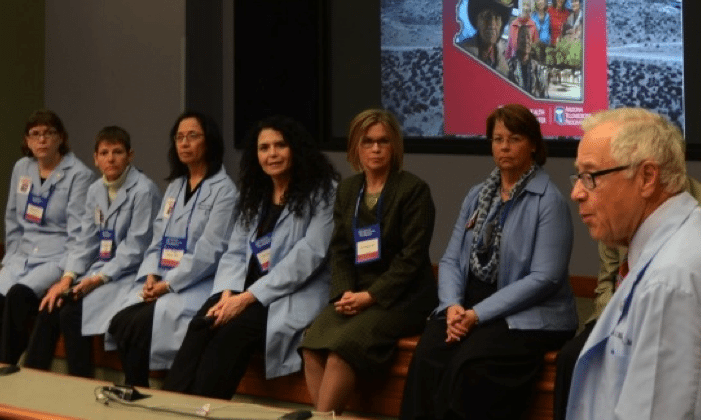A sellout crowd eager for information about telemedicine services attended the recent inaugural Northern Arizona presentation of the Arizona Telemedicine Program (ATP)’s full-day telemedicine training conference, “Arizona Telemedicine Course: Applications, Infrastructure, Reimbursement.” Held in Flagstaff, the conference featured nationally recognized speakers representing several high-profile Arizona telehealth programs that are using the technology to improve patient health.
Designed for those who are new to telemedicine as well as those interested in expanding the scope of their telemedicine services, the conference covered patient and provider education programs that take place via video, as well as medical specialty services, including teleneurology, telestroke, tele-epilepsy, teleradiology, telecardiology, telediabetes and telepsychiatry.

“I think it’s well rounded and I appreciate the opportunity to have this in Northern Arizona,” said participant Cheri Wells, director of behavioral health for Flagstaff-based Native Americans for Community Action, which started a telebehavioral health program about a month ago. “I’ve learned a lot about the big picture of telemedicine and its administration as well. I really appreciate learning about all the resources that are available online and through ATP.”
For Wells, the highlight of the training was a presentation by telepsychiatrist Sara Gibson, MD, telemedicine medical director for the Northern Arizona Regional Behavioral Health Authority (NARBHA). “Dr. Gibson’s talk validated the need for and feasibility of telemental health in rural Northern Arizona,” she said.
Attendee Lynn Bedonie, telemedicine/school health specialist for Tuba City Regional Health Care Corporation, has been involved in telemedicine for more than 16 years. “We were one of the original charter sites for the Arizona Telemedicine Program,” she said. “So I’ve been there from the beginning, from when we used modems to now—and everything in between.”
Bedonie came to the training to learn more about billing and teleneurology. “A lot of it was really informative, even though I’ve been to several of these,” she said. “The information changes all the time.”
The conference’s overview of telemedicine, telehealth and mobile health, and in-depth look at clinical applications of the technology, showcased Arizona telemedicine programs. It also featured talks on program assessment, business considerations, equipment and vendor selection, and secrets to success.
Gigi Sorenson, director of telehealth for Northern Arizona Healthcare (NAH), was one of the speakers. “I came hoping to learn more about other programs across the state and also to hear the needs of the state,” she said. Among other NAH telemedicine programs, Sorenson heads up “Care Beyond Walls and Wires,” which has improved patient health and reduced hospital readmission rates through home monitoring systems.
“I thought it was a very comprehensive program,” she said, citing the opportunity for casual conversation and questions at the end of every presentation as the most helpful part of the conference. “I’m very happy that it was held in Flagstaff, and grateful for the opportunity to showcase all the work that’s being done in Northern Arizona.”
This marks the first time the training program has been offered onsite in Northern Arizona, but not the last. “We will be offering this program in Flagstaff at least annually from now on,” said ATP Director Ronald S. Weinstein, MD. “The response was overwhelming; people were wait-listed. We want to ensure that all those who are interested get a chance to attend this training.”
Sorenson agreed: “You could see by the participation in the auditorium that repeating this at least on an annual basis is well worth the time and effort.”
NAH was one of the co-sponsors of the conference, along with NARBHA and North Country HealthCare (NCHC), the parent organization of Flagstaff Medical Center, Verde Valley Medical Center (VVMC) and the VVMC Sedona Campus. NAH, NARBHA and NCHC currently operate successful telehealth programs based in Flagstaff. Together with ATP, they form the Northern Arizona Telemedicine Alliance, a partnership aimed at encouraging and enhancing telemedicine services in the northern part of the state.
ATP is one of five telehealth training programs in the country accredited by the American Telemedicine Association (ATA), the largest telemedicine organization in the world. An internationally recognized leader in telemedicine and e-health training, ATP has been presenting its training program at the University of Arizona’s Arizona Health Sciences Center in Tucson for 15 years, and an expanded version of the program including ATP’s T-Health Institute in Phoenix via videoconference since 2007.
The inaugural Northern Arizona conference attracted 85 attendees representing private and governmental health-care systems and hospitals; community health centers and behavioral health clinics; tribal health departments and medical centers; and commercial telemedicine medical services providers. Participants included CEOs and other senior leadership; doctors, nurses and other health-care professionals; IT directors and staff; administrators at all levels; and health educators. They came from all over Arizona and beyond, with experience levels ranging from clinicians just starting to think about using telemedicine in their private practices to hospital senior administrators who want to add sites and services to their already successful telemedicine programs.




